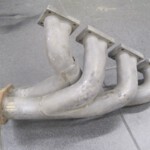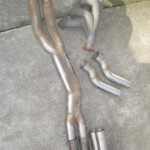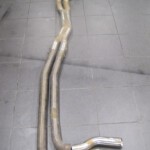For the exhaust we did not dare to take too many risks because with a good design you can gain some power, but the reverse is equally true. Before you know it, you will lose 15-20 hp. Since the courses thermodynamics, physics and mathematics are not so fresh in our memory anymore and especially because we do not have the necessary test facilities, there was only 1 good solution … buy a good exhaust.
The exhaust header was quickly determined, the Gr A rally header from BMW Motorsport is the best choice for us.
There are some impressive 4 in 1 exhaust collectors for the S14 engine including those of zero exhaust in the UK. These are mainly aimed at DTM style applications, which means extreme camshafts and ditto speeds. Because our focus is mainly on torque, we don’t really like those high revs. The only thing we are going to change at the header is 4 inserts for thermocouples so that we can measure the exhaust gas temperature of each cylinder. Furthermore, it must be blasted for a while and then provided with a ceramic layer on the outside to bring down the temperature under the hood. Aesthetically, it is also a nice bonus. The coatings are available in different colours.
For the middle part where the infamous X-pipe normally sits, we got the mustard from Hartge. In the large oval centerpiece there are partitions at certain distances that cause the exhaust gases to change tubes a few times in order to enter the fresh mixture, as it were, at certain times. We assume that hartge has thought very carefully about this and will not change anything about it anyway. However, we are going to put 2 inserts somewhere in the downpipe for broadband lambda sensors. For the time being, these sensors will only be used as an aid in mapping and as a watchdog to prevent the mixture from becoming too poor or too rich. However, we are not going to feed this back into the rule loop. The mixture is therefore not calculated with these sensors, but they give a signal to, for example, limit speed, turn off the engine or go into emergency program …
Everything that comes after this is less important and therefore simply consists of tube where we try to put the largest possible absorption damper somewhere near the original fuel tank to get the sound to an acceptable level.
We finally come out from under the car just before the right rear wheel.
An additional advantage of the side exhaust is that we do not have to go under the rear axle, and the risk of a closed exhaust pipe is very much reduced.
By removing the insulation mats, the temperature in the car on the passenger side will always be a few degrees higher than on the other side.



